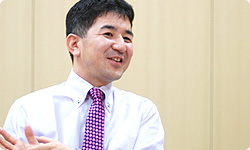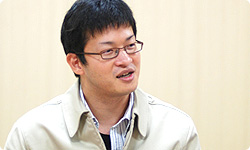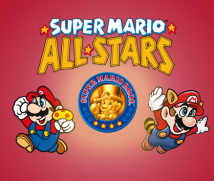3. Music Follows Function
From the point of view of someone following in Kondo-san’s wake, what are you thinking as you create the music for the Mario games?
What I think now as I work on the music for Mario games is that I want to make music that doesn’t let players stand still - music that is always moving forward, if only one step.
You try to make music that will make players want to keep moving forward.
Right. If the tune is enjoyable and invigorating, the person listening to it will feel positive and feel free to move forward without looking back.
I see.
(laughs) Kondo-san, what do you think?
What a truly amazing analysis.
I feel like that’s the first time you ever complimented me.
(laughs)
For the most part, each level in a Mario game can be played in about two minutes, so if you make a song about one minute long, you can run through it twice, maybe three times at the most, and you’re at the goal.
But in the case of a Mario game, when you reach a difficult part, you have to try the same part over and over again.
Right.
The game is kind of like boot camp. As you keep trying, you end up listening to the same song for a long time.
That’s right. So I’m especially careful about the intro. I put a lot of effort into about the first two measures. Mario games are replayed a lot, so you hear the intro a lot. I try to make intros that players won’t get sick of hearing, intros that will always…

Will always make players feel positive?
Yes. I try to make an intro that will help players stay positive no matter how many times they fail.
You put every effort into the music, especially the intro, to give players courage.
Right. I think the songs that Kondo-san has made have that kind of power, so you can listen to them again and again and feel like, “All right, one more time!” And ever since the first Super Mario game, simply listening to an intro would immediately call to mind what song it was and what level it belonged to, and I’ve tried to continue that. When other developers make music for a Mario game, I give them a little advice, telling them to pay special attention to the intros.
Kondo-san?
That’s exactly right. Video game music is different from movie music. I think it’s more like music for television commercials. An intro is important as a kind of sign that as soon as you hear it, it instantly tells you what song it is, and even if the level changes, what level you’re on.
And you have to convey to players what kind of place they’re in with a mere one or two measures.
That’s right. And it’s true for both Zelda and Mario games. The music for the dungeons in Zelda is made so that as soon as you hear it, it’s like a sign appearing and telling you that you’re someplace completely different than the other dungeons.
I think that has a lot to do with Miyamoto-san’s background in industrial design. In a Mario game, graphic design is dictated by function. The music also follows function.
I think so.
The first impression that the music makes shows you the game world. Mario games don’t have very complicated stories anyway.
Time after time, Princess Peach gets abducted, and every time Mario has to go rescue her. (laughs)
That’s right. (laughs) It’s like the music in a silent film. Just by listening to the music, you can tell what kind of story is unfolding. That’s the characteristic of Mario games.
That’s right.
We don’t explain through text messages what situation the player is in, so it’s music in the world of the Mario games that tells players as soon as they hear it whether they’re in danger, or safe, or need to hurry, or can take their time.
You really do represent function through music.
Right. Recently there have been more occasions during in-company training when I’ve had the opportunity to explain how we make the music for the Mario games. I explain how we strive to create a sound that will convey to players through the music alone what kind of level lies before them and how they should approach it. For example, for a particular level with lots of difficult jumps, we’ll use music that tells them ahead of time they’re approaching some athletic leaps and bounds.
You prepare them with music.
Exactly. We have them get ready ahead of time.
Well, Kondo-san, is he right?
(happy) Yeah!
(laughs)
Good! (laughs) I think I’m starting to understand the essence of the Mario sound.
With regard to graphic design, representing function is important, and that applies to music as well.
That’s right.
Kondo-san once told me that we try not to use any sounds that will really make players feel bad - like when he gets done in by an enemy, he flips up in a comical way.
You use sound to make players think, “Oh well, I’ll try again.”
Right.
It’s important that we say “Play again!” rather than “You’re done for!”
When I was a kid, I played all kinds of games, and that was the difference between Super Mario and other games. With other games, when I made a mistake, I would get mad, but with a Mario game, I would think, “I’m gonna try again!”

That was probably because Kondo-san was telling you through the music to do just that! (laughs)
Probably! (laughs)
And when Mario loses a turn, it isn’t sombre. I think it’s great that people watching can laugh because of that.
Even though the player may let out a yelp! (laughs)
